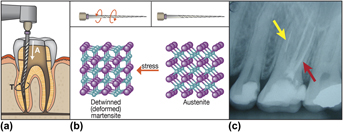Crossref Citations
This article has been cited by the following publications. This list is generated based on data provided by
Crossref.
Naffakh, Mohammed
Díez-Pascual, Ana M.
Marco, Carlos
Ellis, Gary J.
and
Gómez-Fatou, Marián A.
2013.
Opportunities and challenges in the use of inorganic fullerene-like nanoparticles to produce advanced polymer nanocomposites.
Progress in Polymer Science,
Vol. 38,
Issue. 8,
p.
1163.
M.A. Chogle, Sami
M. Kinaia, Bassam
and
E. Goodis, Harold
2013.
Nanobiomaterials in Clinical Dentistry.
p.
431.
Levi, Roi
Bar-Sadan, Maya
and
Tenne, Reshef
2013.
Springer Handbook of Nanomaterials.
p.
605.
Goldbart, Ohad
Yoffe, Alexander
Cohen, Sidney R.
Rosentsveig, Rita
Feldman, Yishay
Rapoport, Lev
and
Tenne, Reshef
2013.
New Deposition Technique for Metal Films Containing Inorganic Fullerene‐Like (IF) Nanoparticles.
ChemPhysChem,
Vol. 14,
Issue. 10,
p.
2125.
Redlich, Meir
and
Tenne, Reshef
2013.
Nanobiomaterials in Clinical Dentistry.
p.
259.
Goldbart, Ohad
Elianov, Olga
Shumalinsky, Dmitry
Lobik, Leonid
Cytron, Shmuel
Rosentsveig, Rita
Wagner, H. Daniel
and
Tenne, Reshef
2013.
Study of urological devices coated with fullerene-like nanoparticles.
Nanoscale,
Vol. 5,
Issue. 18,
p.
8526.
Di Luccio, Tiziana
Borriello, Carmela
Bruno, Annalisa
Maglione, Maria Grazia
Minarini, Carla
and
Nenna, Giuseppe
2013.
Preparation and characterization of novel nanocomposites of WS2
nanotubes and polyfluorene conductive polymer.
physica status solidi (a),
Vol. 210,
Issue. 11,
p.
2278.
Naffakh, Mohammed
and
Díez-Pascual, Ana M.
2014.
Nanocomposite biomaterials based on poly(ether-ether-ketone) (PEEK) and WS2 inorganic nanotubes.
Journal of Materials Chemistry B,
Vol. 2,
Issue. 28,
p.
4509.
Asadi, Vahid
Jafari, Seyed Hassan
Khonakdar, Hossein Ali
Häuβler, Liane
and
Wagenknecht, Udo
2016.
Incorporation of inorganic fullerene-like WS2 into poly(ethylene succinate) to prepare novel biodegradable nanocomposites: a study on isothermal and dynamic crystallization.
RSC Advances,
Vol. 6,
Issue. 6,
p.
4925.
Gracco, Antonio
Siviero, Laura
Dandrea, Martina
and
Crivellin, Giorgia
2016.
Nanobiomaterials in Dentistry.
p.
241.
Kaplan-Ashiri, Ifat
and
Tenne, Reshef
2016.
On the Mechanical Properties of WS2 and MoS2 Nanotubes and Fullerene-Like Nanoparticles: In Situ Electron Microscopy Measurements.
JOM,
Vol. 68,
Issue. 1,
p.
151.
Panchakarla, Leela S.
and
Tenne, Reshef
2017.
Nanotechnology for Energy Sustainability.
p.
745.
Zafar, Muhammad S.
Khurshid, Zohaib
Najeeb, Shariq
Zohaib, Sana
and
Rehman, Ihtesham Ur
2017.
Nanostructures for Oral Medicine.
p.
833.
Zhu, Jianing
Zeng, Qunfeng
and
Fu, Tao
2019.
An updated review on TiNi alloy for biomedical applications.
Corrosion Reviews,
Vol. 37,
Issue. 6,
p.
539.
Cardona, Angelo
Iacovacci, Veronica
Mazzocchi, Tommaso
Menciassi, Arianna
and
Ricotti, Leonardo
2019.
Novel Nanostructured Coating on PDMS Substrates Featuring High Resistance to Urine.
ACS Applied Bio Materials,
Vol. 2,
Issue. 1,
p.
255.
Levin, Tzuriel
Sade, Hagit
Binyamini, Rina Ben-Shabbat
Pour, Maayan
Nachman, Iftach
and
Lellouche, Jean-Paul
2019.
Tungsten disulfide-based nanocomposites for photothermal therapy.
Beilstein Journal of Nanotechnology,
Vol. 10,
Issue. ,
p.
811.
Redlich, Meir
and
Tenne, Reshef
2019.
Nanobiomaterials in Clinical Dentistry.
p.
309.
Chogle, Sami
Kinaia, Bassam M.
and
Goodis, Harold E.
2019.
Nanobiomaterials in Clinical Dentistry.
p.
517.
Zhang, Yanan
Liu, Bingfei
Du, Chunzhi
and
Zhou, Rui
2019.
On the behaviors of porous shape memory alloy beam with gradient porosity under pure bending.
Journal of Materials Research,
Vol. 34,
Issue. 2,
p.
282.
Zakrzewski, Wojciech
Dobrzyński, Maciej
Zawadzka-Knefel, Anna
Lubojański, Adam
Dobrzyński, Wojciech
Janecki, Mateusz
Kurek, Karolina
Szymonowicz, Maria
Wiglusz, Rafał Jakub
and
Rybak, Zbigniew
2021.
Nanomaterials Application in Endodontics.
Materials,
Vol. 14,
Issue. 18,
p.
5296.
